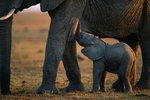
Although marsupials and placental animals are both mammals, there are several distinguishing features that differentiate the two groups. Placentals include humans, whales, mice, cats, cows, dogs and an additional 5,500 species, which can be found on every continent but Antarctica. There are fewer than 300 known marsupial species — all of which inhabit Australia, South America and Central America — including kangaroos, opossums, koalas, wombats and Tasmanian devils. Only one marsupial is indigenous to North America, the Virginia opossum.
The Fundamental Difference
The biggest difference between marsupials and placentals lies in the possession a placenta, the oxygen- and nutrient-rich organ that attaches growing embryos of placental mammals to their mothers. Marsupials, on the other hand, have no internal placenta and must therefore absorb nutrients from the yolk of their ovum; however, once the young are born, they spend a much longer time suckling than do placental young. Essentially, marsupials spend far more time nurturing and nursing their young after they are born than placentals, mammals that invest more time and energy in pregnancy.
The Marsupial Pouch

If there's one thing marsupials are known for, it's the characteristic pouch in the female of the species. Strictly speaking, not all marsupials have pouches, but the majority do. In fact, the pouch itself varies among species, as marsupials can have one of three types of pouches that vary in size and strength. Some species have permanent pouches, while other marsupials only develop a pouch when the reproduction process begins, according to the Animal Diversity Web: Metatheria. Instead of the complex placenta that passes nutrients on to embryonic placental mammals, marsupials use their pouches to provide nutrition and safety, as their pouches cover the nipples to which the young are almost constantly attached.
Marsupial vs. Placental Teeth
For the most part, marsupials have more teeth than their placental counterparts, although certain species may have different kinds of teeth. Two such animals include common wombats and brushtail opossums, both of which have only two incisors on their lower jaw, whereas placental mammals — and indeed, most other marsupials — have four lower incisors. According to the University of Edinburgh: Anatomical Differences Between Marsupial and Placental Animals website, while most placentals have four premolars and three molars lining both the upper and lower jaws, marsupials have three premolars and four molars in the same region. The other key difference between the teeth of placental mammals and marsupial mammals is that placentals usually have two sets of teeth — one set that grows in young animals and another set of adult teeth that replace full sets of “baby teeth,” whereas marsupials can only replace certain teeth.
Differences in Reproduction Anatomy and Systems
The most profound differences between placentals and marsupials lie in their respective reproductive systems and anatomy. While the sex organs and reproductive habits of male marsupials and placentals don't differ all that much, the same cannot be said of females, who couldn't be more divergent. Female marsupials have two fully developed sets of reproductive structures, including two vaginae, two cervices, two uteri and two fallopian tubes. With the exception of two fallopian tubes, female placentals only have one of each of these other organs. Marsupials' vaginae are laterally positioned on either side of the ureter, and either one is capable of being fertilized. When it's time to give birth, the two vaginae close together and fuse, forming a median vagina, also called a pseudo birth canal. After a marsupial's first birth, this canal usually will reform until the next birth, however, in a few species, it can remain open permanently.
Gestation and Rearing Differences
Compared to placental mammals, marsupials gestate only for a brief period. Young placentals experience a tremendous amount of in utero growth and development, so most of these animals' young — with the marked exception of humans — are born with the physical traits and capabilities of their adult parents. Conversely, marsupials do most of their development after being born, when the tiny infants immediately make their way to the pouch to continue developing and to find consistent and complex nourishment, as the mother marsupial's two teats provide different milk designed to suit the different stages of development of her young. Due to the comparatively brief marsupial gestation period, many species can be in three stages of reproduction simultaneously. This phenomenon occurs when a female is pregnant with a newly formed embryo, has one joey still attached to her teat and tucked inside her pouch and is still rearing a sibling attached to her other teat.
References
Resources
Photo Credits
-
Tom Brakefield/Stockbyte/Getty Images




